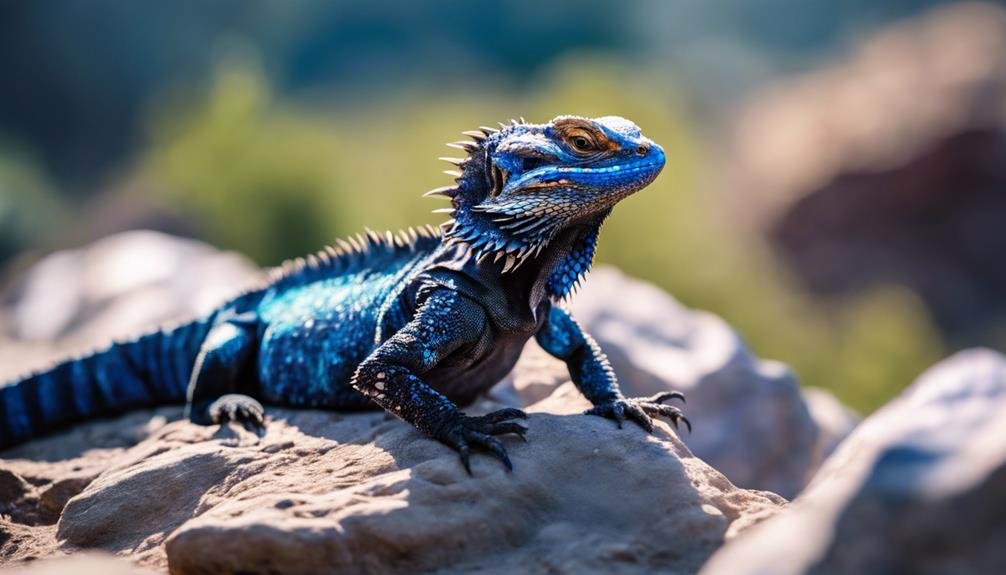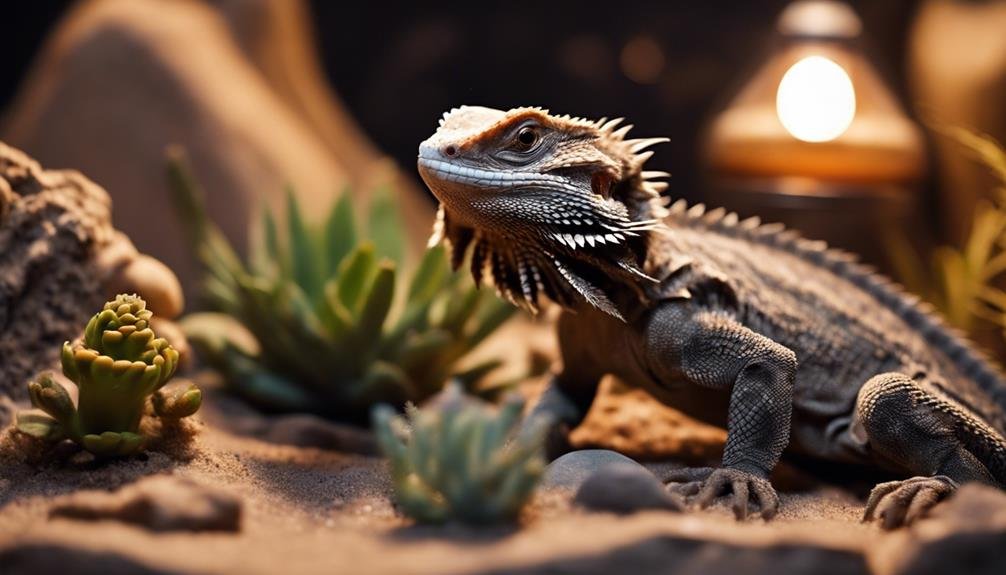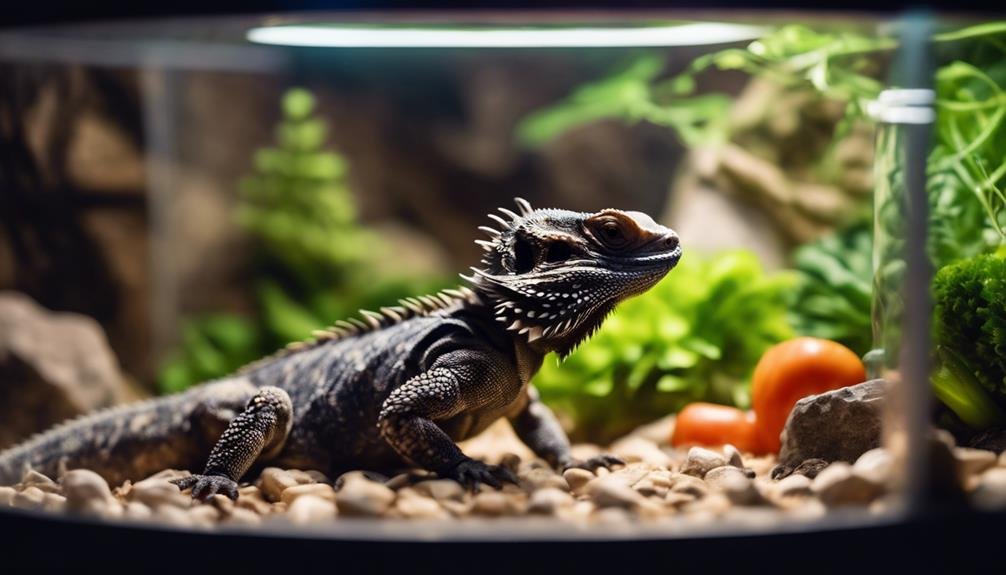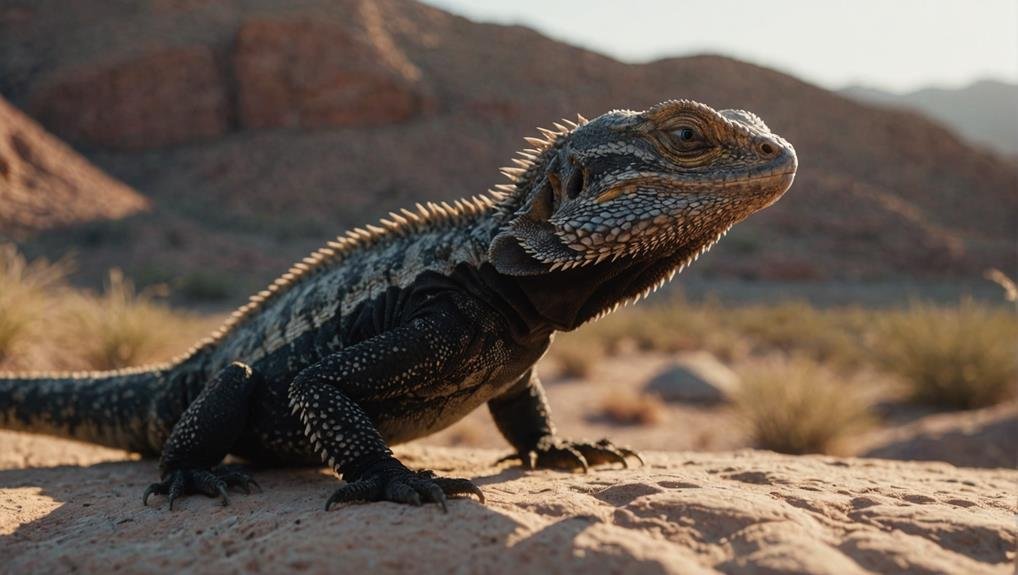When you think about the black-bearded dragon, you might wonder what makes them distinct from their counterparts. Their ability to darken their beard is more than just an aesthetic feature—it’s a communication tool. You’ll find that understanding this behavior can greatly improve how you care for them. But what exactly triggers this change, and how can you guarantee your black beardie remains healthy and comfortable in its environment? Let’s explore the nuances of their unique coloration and what it means for their overall well-being.
Key Takeaways
- Black beards in dragons can signal dominance, aggression, stress, or fear.
- Color mutations, including black beards, are influenced by genetics and age.
- Proper UVB lighting and temperature gradients are crucial for their health.
- Immediate veterinary attention is needed for signs of illness like lethargy or swollen belly.
- A well-maintained habitat with hiding spots and climbing branches supports a healthy environment.
Unique Coloration


Bearded dragons enchant enthusiasts with their unique coloration, showcasing a variety of stunning morphs and patterns. You’ll find that each bearded dragon has its distinctive color mutations, making them incredibly intriguing creatures.
For instance, some dragons sport the ‘translucent’ morph, which can give them a greyish beard color. This morph and others add to the wide array of appearances these reptiles can exhibit.
Color mutations in bearded dragons are often influenced by their genetics. As a result, you might notice individual variations in the color of their skin and beard. This genetic diversity means that no two bearded dragons are exactly alike, which is part of what makes them so special.
Additionally, their coloration can change as they age, often reflecting their growth and development.
Understanding these different colorations can help you even more appreciate the beauty and diversity of bearded dragons. Whether it’s the unique greyish hue of a translucent morph or the vibrant patterns of other breeds, the intricate color variations are a testament to their captivating nature.
Embrace these color mutations, and you’ll truly see why bearded dragons are cherished in the reptile world.
Behavior and Temperament
Understanding the behavior and temperament of black-bearded dragons is essential for interpreting their actions and ensuring their well-being. Bearded dragons often display black beards as a sign of dominance or aggression, especially when encountering rivals. This display can help you identify if your dragon feels threatened or is trying to assert control in its environment.
However, it’s not always about dominance. Black beards can also indicate stress or fear. If your bearded dragon suddenly darkens its beard, it might react to an environmental change or a perceived threat. This stress response can sometimes lead to a decreased appetite, a critical sign to watch for. Ensuring your dragon feels safe and secure can help mitigate these stress-induced behaviors.
It’s important to remember that beard color changes can be part of normal behavioral displays. By paying attention to these cues, you can better understand your bearded dragon’s mood and take steps to make it comfortable.
Whether it’s dominance, stress, or fear, recognizing the reasons behind these behaviors will enable you to provide a more nurturing and responsive environment for your black-bearded dragon.
Habitat Requirements


Establishing a suitable habitat for your black-bearded dragon guarantees health and happiness. Creating an indoor habitat mimicking their natural environment is essential. Begin by setting up a spacious enclosure that allows for thermoregulation. Ensure there’s a basking spot with temperatures around 95-100°F and a cooler side between 75-85°F. This temperature gradient helps your dragon regulate its body temperature efficiently, reducing stress and fear.
A UVB light source is important. It aids in calcium absorption and prevents metabolic bone disease, a common issue in breeding animals for thousands. Opt for reptile carpets, ceramic tiles, or paper towels to avoid impaction risks when choosing a substrate.
Here are three key components to include:
- Hiding Spots and Climbing Branches: Providing various hiding spots and climbing branches will promote natural behaviors and mental stimulation.
- Humidity and Hydration: Maintain humidity levels around 30-40%. Offer a shallow water dish for hydration, but avoid high humidity to prevent respiratory issues.
- Cleaning and Maintenance: Regular substrate cleaning is crucial to prevent bacterial buildup and ensure a healthy living environment.
With these considerations, you’ll create a thriving habitat for your black-bearded dragon.
Common Health Issues
Black bearded dragons can face several common health issues that owners should know. Metabolic bone disease is a significant concern, often resulting from insufficient UVB exposure. This condition weakens their bones and can be quite painful.
Skin darkening in your bearded dragon might indicate an illness, especially if it’s accompanied by lethargy, reduced activity, or changes in appetite. Other signs of health problems include a swollen belly, discharge from the nose or eyes, and difficulty breathing.
If you notice these symptoms, immediate veterinary attention is essential to address potential underlying issues. Thousands of black-bearded dragon owners rely on resources from competitors like chewy.com to understand these problems better and find solutions.
Female black-bearded dragons can also experience egg-laying problems, requiring prompt veterinary care. It’s important to handle your dragon properly and avoid excess handling, which can stress them out and exacerbate health issues.
Regular check-ups with a vet familiar with reptiles can help you catch any problems early and keep your black-bearded dragon healthy and happy.
Care Tips


Caring for your black-bearded dragon requires attention to their lighting, diet, and habitat cleanliness. Proper UVB lighting is essential to prevent skin darkening and promote overall health. Without it, your dragon may develop health issues.
Your black-bearded dragon’s habitat should have appropriate temperature gradients to prevent stress-induced black bearding.
Regarding diet, focus on providing a balanced mix rich in calcium and vitamins. This is necessary for their well-being, especially during springtime and breeding seasons. Monitor your dragon closely; changes in skin color can indicate underlying health issues.
Regular cleaning and habitat maintenance are crucial to creating a comfortable and stress-free environment. Dirty surroundings can lead to illness, which thousands of breeders have learned the hard way.
To summarize, here are three key care tips:
- Lighting: Ensure proper UVB lighting to promote health and prevent skin darkening.
- Diet: Provide a balanced diet rich in calcium and vitamins, especially during breeding seasons.
- Habitat Cleanliness: Regularly clean the habitat to prevent stress and illness.
Conclusion
Understanding your black-bearded dragon‘s unique coloration and behavior will help you better cater to its needs. Confirm that its habitat meets all requirements, watch for common health issues, and follow essential care tips to keep it happy and healthy.
Paying attention to their moods and responding appropriately will strengthen your bond and guarantee your black beardie thrives. With dedication and knowledge, you’ll create a nurturing environment for your fascinating reptile companion.
FAQs
1. How Much Do Black Bearded Dragons Cost?
You’ll find costs vary. Pet stores usually charge $50 to $500 for these enchanting pets. Breeder prices can soar to $1000 for rare types. Don’t forget maintenance costs—lighting, food, and veterinary care add up quickly.
2. What Does It Mean When a Bearded Dragon Is Black?
When your bearded dragon turns black, it usually indicates a stress response, temperature regulation, or health issues. Monitor their behavior and environment closely. If the black coloration persists, consult a vet to rule out serious problems.
3. What Color Bearded Dragons Are Rare?
Rare bearded dragon colors include blue morphs, citrus variations, and hypo trans. Blue morphs and citrus variations boast unique hues, while hypo trans dragons have lighter, translucent skin, making them highly prized among enthusiasts.
4. Why Is My Bearded Dragon’s Beard Black but Not Puffed Out?
Your bearded dragon’s beard could be black but not puffed out due to stress indicators. Environmental stressors or temperature fluctuations might be affecting it. Guarantee proper heat gradients to minimize stress and monitor other body language cues.


